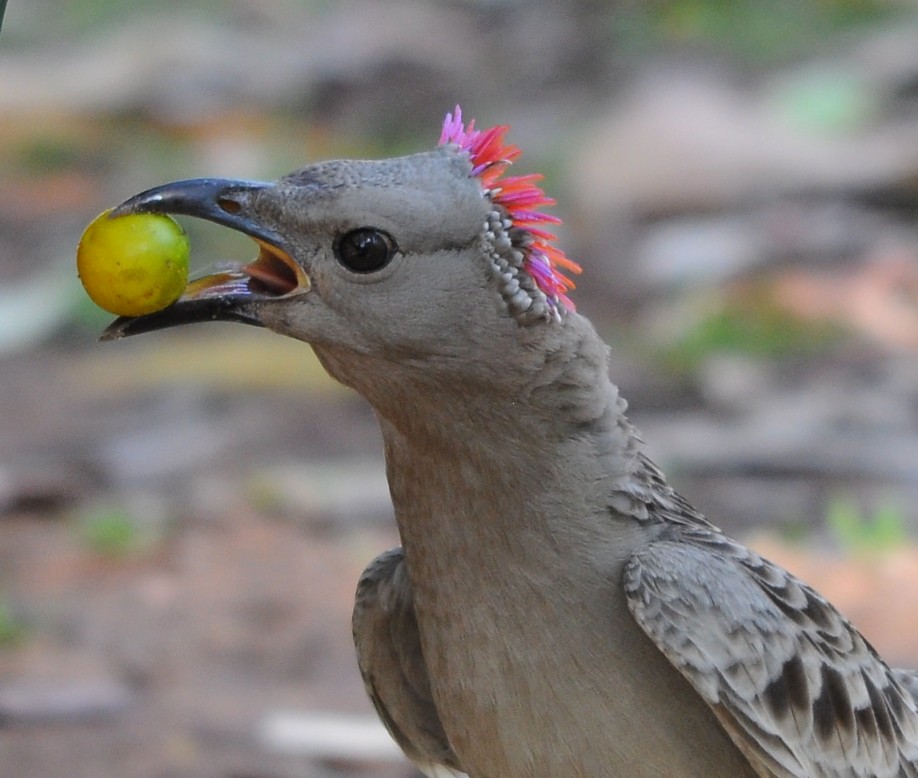One of the earliest memories I have of developing a love of birds was when I saw and heard a Superb Lyrebird (Menura novaehollandiae) for the first time. Growing up on the South Coast of NSW I was lucky enough to be able to venture into their habitat and witness first hand their incredible antics. Watching a lyrebird perfectly mimic the sound of a Laughing Kookaburra (Dacelo novaeguineae) blew my mind and I have since heard them while camping mimic the sound of campers banging in tent pegs. I have also been
fooled and amazed when I heard what I thought was the unmistakable call
of a Whistling Kite (Haliastur sphenurus) coming from a mango tree in Kakadu National Park,
only to discover it was emanating from a Great Bowerbird (Chlamydera nuchalis). It is not just lyrebirds and bowerbirds that mimic other birds and environmental noises, it is suggested that 15-20% of passerines incorporate heterospecific elements into their songs (Zann & Dunstan 2008).
The male Superb Lyrebird (Menura novaehollandiae) has possibly the greatest song repertoire in the world. His ability to to accurately mimic up to 20 different species of birds along with many other environmental noises is truly amazing https://www.youtube.com/watch?v=VjE0Kdfos4Y. Viewed on 12th April 2017.
So why do birds vocally mimic other bird species? The short answer is that we still don't really know. There have been many theories put forward that have tried to answer this complex question, one of which is that female preference for song complexity has resulted in mimicry to enlarge the male's song repertoire (Zann & Dunstan 2008). Research has since shown that in some species of birds, accuracy of vocal mimicry and size of repertoire in males can predict mating success better than other display traits that have been determined as important for male mating success (Coleman et al. 2007). The fact that mimicry is a learned behaviour requiring the modification of vocal motor patterns (Zollinger & Suthers 2004) has prompted the idea that mimicry accuracy may provide females with information as to the male's past (Nowicki et al. 2002) and present (Garamszegi 2005) condition and serve as an honest indicator of physiological performance (Coleman et al. 2007).
 |
| The Great Bowerbird (Chlamydera nuchalis) is also an excellent mimic and has certainly fooled me more than once! It has been suggested that Great Bowerbirds mimic predators to protect their nest, however field evidence does not support this hypothesis. Image sourced from https://www.flickr.com/photos/21342600@N03/5024267447. Viewed on 13th April 2017. |
Researching vocal mimicry in birds has once again highlighted the many complexities embedded within the avian world we do not, and may never, fully understand. It seems to me that researchers are often at risk of trying to prove each other wrong when in fact given the sheer diversity and vastly different characteristics of birds, in some cases there may be as many answers to the same question as there are species of birds.
References
Coleman, S.W., Patricelli, G.L., Coyle, B., Siani, J. & Borgia, G. 2007, "Female preferences drive the evolution of mimetic accuracy in male sexual displays", Biology Letters, vol. 3, no. 5, pp. 463-466.
Garamszegi, L.Z. 2005, "Age-dependent health status and song characteristics in the barn swallow", Behavioral Ecology, vol. 16, no. 3, pp. 580-591.
Nowicki, S., Searcy, W. & Peters, S. 2002, "Brain development, song learning and mate choice in birds: a review and experimental test of the "nutritional stress hypothesis"", Journal of Comparative Physiology A, vol. 188, no. 11, pp. 1003-1014.
Zann, R. & Dunstan, E. 2008, "Mimetic song in superb lyrebirds: species mimicked and mimetic accuracy in different populations and age classes", Animal Behaviour, vol. 76, no. 3, pp. 1043-1054.
Zollinger, S.A. & Suthers, R.A. 2004, "Motor mechanisms of a vocal mimic: implications for birdsong production", Proceedings of the Royal Society of London. Series B: Biological Sciences, vol. 271, no. 1538, pp. 483-491.
Vocal mimicry is quite fascinating and it’s obvious why birds are of such an interest! Has anyone actually looked at the mechanics or the structures that allow for such an ability to mimic? I’m just wondering if there is something special about these structures compared to other species that don’t mimic so well.
ReplyDeleteI did briefly look into this when researching mimicry and I found an in depth article (below) that provided a comparison of sound generation in birds and humans that was really interesting. While quite complex, it provides a physiological explanation as to how birds are able to produce the complex sounds they do, including mimicry - but not an explanation as to why!!!
ReplyDeleteRiede, T. & Goller, F. 2010, "Peripheral mechanisms for vocal production in birds – differences and similarities to human speech and singing", Brain and Language, vol. 115, no. 1, pp. 69-80.